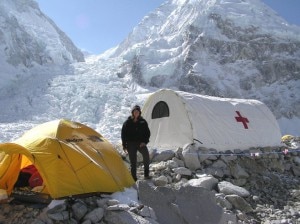(English) Rescuing climbers not an easy task


Dr. Luanne Freer at the temporary medical post of Himalayan Rescue Association (HRA) at the Everest Base Camp. Photo Courtesy: HRA.
KATHMANDU, Nepal–The challenges facing the emergency rescue operations and medical treatment of climbers during mountaineering and trekking always become the talk of town during the peak mountaineering season when domestic and foreign tourists flock the adventurous trails and the risky peaks in Himalayan nation.
Foreign and domestic climbers are frequently encountered with numerous mountain related problems like Acute Altitude Sickness (AAS), risks of slipping down cliffs, sweeping away by avalanche and sometime fall to death though the stakeholder concerned have been claiming of managing the rescue operations more effectively.
On the other hand, the rescue organizations said they are also facing the various problems and challenges while rescuing mountaineers and trekkers.
D.B Koirala, president of Himalayan Rescue Association (HRA) Nepal says they face hardships while rescuing the mountaineer in hour of need due to lack of chopper and enough fund.
“We are prepared to treat the patient at the incident site but if the patient demands a helicopter or the person´s situation is critical we call helicopter for immediate rescue,” National news agency Rastriya Samachar Samiti (RSS) quoted Koirala as saying adding it is really hard to hire chopper by the company itself.
With an objective to reduce casualties in the Nepal Himalayas and keeping in view the increasing number of Nepalese and foreigners who trek up into the remote mountain, HRA was established in 1973.
One of the crucial tasks the HRA is to try to prevent deaths from Acute Mountain Sickness that confronts foreign climbers and trekkers. For the last 39 years, the HRA has helped make a safer Himalaya for tourism.
According to Koirala, the HRA at present has a capacity to treat at least 200 foreigners by taking fees from mountaineers. The HRA complains that it lacks fund to treat ailing mountaineers who need emergency rescue while in their expeditions.
HRA has already rescued a total of 1,229 among which Nepali were 855 and 364 foreigners while in 2013 the number of people to get rescued from the association was 3,430 Nepali and 963 foreigner alpinist.
Since its establishment, it has staffed a small aid post in the Khumbu village of Pheriche at an altitude of 14,343 feet. The Pheriche aid-post is manned twice yearly during the trekking season by volunteer doctors.
Tourism Ministry annually provides the Association Rs. 400,000 to HRA. However the amount is said to be meager since the cost of the medicines amounts to Rs. 40,000 to 50,000.
Like the HRA, Nepal Mountaineering Association (NMA), has also been carrying out rescue operations in the mountains.
The national alpine association set up to promote mountain tourism, climbing sports among other also offers training and other rescue course periodically, keeping in view the possibility of such accidents to make the mountaineering profession more safe and reliable.
The accidents in the Himalayan region have been increased in the recent days due to global warming and climate related event.
NMA has also initiated the process to set up a unit of rescue team to prevent such disasters and expedite rescue process during mishaps.
In the meantime, the Ministry is learnt to have working out the plan to reduce accidents and make rescue attempts more effective soon.
Dr Luanne Freer at the temporary medical post of Himalayan Rescue Association (HRA) at the Everest Base Camp. Photo Courtesy: HRA. Tring! Tring!
